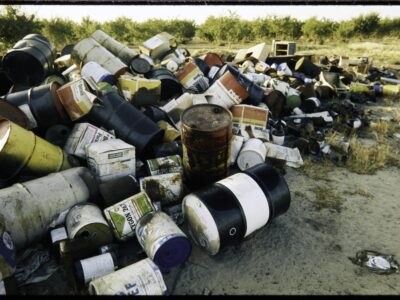This Climate Debate is a lot of Hot Air
Geoengineering is having a moment. But much of the media coverage is failing to capture the actual debate.

We’ve been hearing a lot lately about geoengineering – the various scientific theories and governance ideas that could eventually lead to technological interventions to help cool the planet.
A weather balloon stunt in Mexico by a small startup called Make Sunsets generated a lot of hot headlines, even though that solar geoengineering “experiment” was so tiny that it couldn’t possibly have yielded any physical effects. After the MIT Technology Review broke the news about that weather balloon stunt, the Guardian, the NY Times, Washington Post, CNN, CNBC, Time and other outlets followed with stories.
The notion that private, for-profit actors could take matters into their own hands and start playing with the planet’s thermostat has, understandably, captured the attention of science writers, climate reporters and their editors. Geoengineering is clearly having a media moment. But much of the coverage is failing to accurately reflect the debate around geoengineering. This is largely a problem with stories that seek to present two sides–supporters standing on one side and opponents way over on the other. There are several problems with this false dichotomy:
-
- Entrepreneurs behind private startups like Make Sunset are wildly different from the scientists and environmental law experts who study geoengineering. They shouldn’t be grouped together as a side.
- It gins up a “controversy” when there was nearly unanimous condemnation of the Make Sunsets stunt by people of all perspectives. There is no vigorous, two-sided disagreement over whether to launch more balloons in Baja filled with sulfur dioxide.
- No serious person is advocating for any large-scale deployment of solar geoengineering or substituting it for other urgent climate change mitigations, so the shorthand use of “opponent” or “supporter” is itself misleading and pushes voices to extremes.
- Anyone can float a balloon. Experiments and concepts (and stunts) should be assessed on their own merits if they’re going to be granted a media platform.
Take this recent CNN story titled “Supporters of a controversial climate solution say it could be key. Critics believe it is the path to catastrophe.” That headline suggests there is some silver-bullet geoengineering proposal that “supporters” claim would solve climate change if they were allowed to do it. In fact, the academic sources that this story describes as “supporters” simply support the goal of further studying geoengineering. Which is to say they advocate for pursuing responsible research into scientific technologies, the environmental and societal risks of deploying them, and the legal and governance structures that would be required to prevent use or misuse of these technologies by private companies or state actors. Most of these “supporters” in fact demonstrate a healthy amount of skepticism, if not downright suspicion or pessimism, toward the possible technological interventions. They too worry about the unintended, negative consequences. And they universally say that geoengineering is no substitute for urgent emissions reductions and energy transition.
By contrast, the experts who are quoted as “opponents” in news coverage like the CNN story do not just oppose some specific solar geoengineering experiment. They oppose the very idea of studying geoengineering. “Just because we’re desperate doesn’t suddenly make solar geoengineering a good idea, because the risks are so immense,” Lili Fuhr, from the Center for International Environmental Law, told CNN. But no one thinks doing geoengineering is a good idea, do they? To suggest that those who support the idea of geoengineering research think that deploying it is a good idea is a straw man argument.
The potential risks are legion. They include, but are not limited to, altering rainfall and monsoon patterns, damaging the ozone layer, increasing global conflicts, and – most unacceptable of all – giving political cover for fossil fuel industries to continue polluting rather than cut greenhouse gas emissions. Journalists who are covering future geoengineering developments should interrogate these very risks and concerns to help shed light on the bad set of options.
Here is a list of questions one could start with:
- What do we know, and still not know, about how stratospheric aerosol injection and other solar geoengineering efforts could affect weather, rainfall, and crops?
- How might those risks compare to the altered rainfall patterns, flooding, and extreme heat that we’re already seeing due to climate change?
- Would small-scale field experiments fill in the gaps of what computer modeling can tell us?
- What do the people living in Global South countries most at risk from climate change think about studying geoengineering, and do they deserve a say?
- How will governments deal with private startups if they continue to perform unscientific, unregulated experiments?
- If a corporation or country did unilaterally launch a major geoengineering effort, what would the international community be prepared to do?
- Is there social science data that suggests simply studying geoengineering would deter societies from pursuing urgently needed emissions reductions?
- If we overshoot the 1.5 or 2.0 degree Celsius targets set by the Paris Agreement, what other policies are available?
- Have fossil fuel industries made any move to co-opt, or benefit from, geoengineering? If not, does that assuage the concerns of some opponents?
- Is banning academic research a good way to guide public policy?
OK, that last question is rhetorical. But it sure hasn’t worked well in the case of Schedule 1 drugs. The decades-long prohibition on research into psychedelics only delayed scientific understanding. Now, I personally think ingesting LSD and getting behind the wheel of a car is a terrible idea, but I want scientists to be allowed to research potential therapeutic effects and impaired driving.
One group that’s been surprisingly absent from some, though not all, of this coverage is the Climate Overshoot Commission, which is an independent body of members from around the world who are working on recommendations for a strategy to reduce the risks if global warming goals are exceeded. The commission, which operates as part of the Paris Peace Forum, just wrapped up a meeting this month in Jakarta, Indonesia as they work toward a new report. “The commission is the first international body that’s taken on the mandate of taking seriously the peril and likelihood of exceeding the Paris targets and asking what that means for the appropriate or necessary climate response,” says the UCLA Emmett Institute’s Faculty Director Edward A. Parson. He has played a supporting role in the commission’s work.
It’s possible that in the coming days and weeks, we’ll hear about more rogue experiments by commercially driven startups that want to test out their model for cooling the planet, be it stratospheric aerosol injection or iron salt aerosol interactions or fill-in-the-blank technology I’ve never heard of.
There is bound to be more mainstream news coverage of 1) these rogue experiments and 2) the evolving arguments for and against the further study of geoengineering. Hopefully, journalists and headline writers seek to address them as the distinct phenomenon that they are. And hopefully we all ask tough questions that will get us closer to an agreement on what to do about the set of bad options we’re facing.







Reader Comments